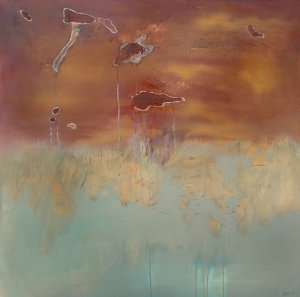 Golden-brown and rust clouds battle a wave of cool, storm-tossed blues. Lush, glossy surfaces are resisted by thickly painted gestural slashes and incised flowing forms. These are just part of the explosion of colors and surfaces found in Con-tin-gen-cies, the current show of new works by Emily Christenson at the doe Gallery in the Bucktown Center for the Arts.
Golden-brown and rust clouds battle a wave of cool, storm-tossed blues. Lush, glossy surfaces are resisted by thickly painted gestural slashes and incised flowing forms. These are just part of the explosion of colors and surfaces found in Con-tin-gen-cies, the current show of new works by Emily Christenson at the doe Gallery in the Bucktown Center for the Arts.
Christenson's works are all rooted deeply in abstraction - an artistic realm of study and expression that too often is either incorrectly dismissed as being "easy" or unfortunately causes discomfort in viewers because they struggle with a preconceived notion that art must have photographic verisimilitude.
According to her short statement, the show's 13 images are "new works on canvas exploring small, unexpected events translated to paint. The imagery is taken from recurred memories, imagined landscapes, or fragmented parts or processes of nature."
Works such as The Day I Gave a Hummingbird a Bath came from the actual experience of a hummingbird flying into the mist from a garden hose and dancing about in the luminous haze. Even the "imagined landscapes" have their genesis in hours of observation.
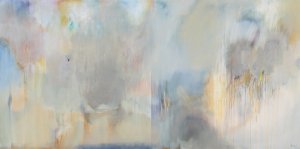 Her empathy for the subject is what distinguishes these works from most abstract paintings and allows them to become highly energized with the artist's passion, intuition, and understanding. These works are not the product of what is commonly referred to as the "slap and hope" method, in which the artist slaps something onto the canvas and hopes that it's good. These paintings are the result of study, patience, and image refinement.
Her empathy for the subject is what distinguishes these works from most abstract paintings and allows them to become highly energized with the artist's passion, intuition, and understanding. These works are not the product of what is commonly referred to as the "slap and hope" method, in which the artist slaps something onto the canvas and hopes that it's good. These paintings are the result of study, patience, and image refinement.
In addition to the conceptual distillations of subject matter, Christenson's works are also conscious of how the paint is applied to the canvas. Brushes, oil sticks, charcoal, and even fingers all leave different kinds of marks on the surface. So the textures throughout the show are alive with call-and-response activities between shiny smooth flows of paint and drips, duller splotches, and thick slashes.
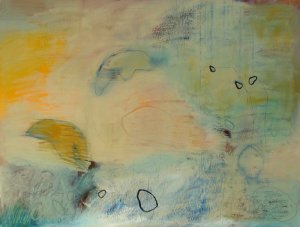 Con-tin-gen-cies features Christenson's explorations with charcoal, oil paint, and pastels, and the luscious effects of processed linseed oil with paint. Processed linseed oil has more of a syrup-like consistency than boiled linseed oil and takes longer to dry. When used thickly, it yields a smooth surface with a succulent gloss, compared to the wrinkled-pudding-skin effect of the boiled. The thickness of Christenson's application sometimes requires up to six months for the surface to dry, but allows the artist to rework and re-initiate surface flows of color on multiple occasions to achieve translucent layers of glossy colors.
Con-tin-gen-cies features Christenson's explorations with charcoal, oil paint, and pastels, and the luscious effects of processed linseed oil with paint. Processed linseed oil has more of a syrup-like consistency than boiled linseed oil and takes longer to dry. When used thickly, it yields a smooth surface with a succulent gloss, compared to the wrinkled-pudding-skin effect of the boiled. The thickness of Christenson's application sometimes requires up to six months for the surface to dry, but allows the artist to rework and re-initiate surface flows of color on multiple occasions to achieve translucent layers of glossy colors.
The six small works on paper, roughly 12 inches by eight, that greet you near the entrance are like fading mental snapshots of a moment captured in paint. These are relatively low-key harbingers of the color and textural dynamism that will be unleashed in Christenson's larger canvases.
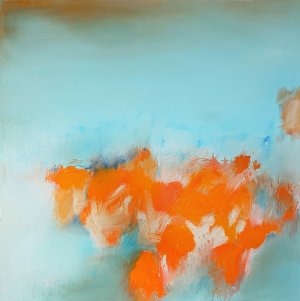 The thin and washed-out under-layers of images and tantalizing ethereal fragments of charcoal scratches coalesce to provide a loose architecture for the thickly painted top layer in the work on paper Dead Stars Create Black Holes. The partial layering of lines, melted pastels, and washes of paint give way to the top layers of smooth paint and linear elements such as incised bubbles and brush-generated ovoids dancing to the left of an acorn-shaped form. Many of the linear motifs established in the works on paper manifest themselves in a variety of intriguing ways throughout Con-tin-gen-cies.
The thin and washed-out under-layers of images and tantalizing ethereal fragments of charcoal scratches coalesce to provide a loose architecture for the thickly painted top layer in the work on paper Dead Stars Create Black Holes. The partial layering of lines, melted pastels, and washes of paint give way to the top layers of smooth paint and linear elements such as incised bubbles and brush-generated ovoids dancing to the left of an acorn-shaped form. Many of the linear motifs established in the works on paper manifest themselves in a variety of intriguing ways throughout Con-tin-gen-cies.
Christenson's larger canvases, by their size and durability, allow her to explore a broader range of surface interactions and color schemes than the more delicate and comparatively monochromatic works on paper.
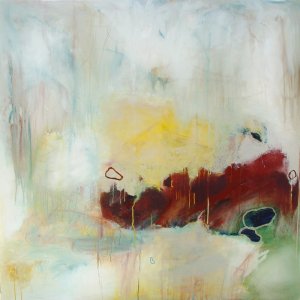 Pastel Veiled is built with satisfyingly thick waves of paint that subsume the underlying frenetic swirls of charcoal and diffused blue pastel. The bulk of the surface is covered with rich and lustrous cool creams and lemon yellows balanced by a small and compositionally vital realm of sanguine and hazy forest green.
Pastel Veiled is built with satisfyingly thick waves of paint that subsume the underlying frenetic swirls of charcoal and diffused blue pastel. The bulk of the surface is covered with rich and lustrous cool creams and lemon yellows balanced by a small and compositionally vital realm of sanguine and hazy forest green.
Not only does a hint of the incised bubble return, but Christenson establishes a small dialogue between a bean-shaped form that has been removed from the canvas and a similar opposite one that is painted on the surface.
The commanding diptych Suougibma is a balancing act between a dense variety of textural marks and large passages of smooth tonal gradations. The outer edges of the two adjoining panels flow gently from a dull pale green into a sky blue before colliding in the center in an explosion of earthen browns, oranges, and rusts.
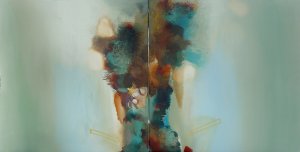 Suougibma also showcases the subtlety and sophistication of Chrsitenson's mark-making. The center masses of colors display a wide range of brush-derived splotches, stabs, slashes, and jabs. The calmer and smoother outer areas contain a series of lightly textural strokes. They resemble densely packed shore-side reeds, which due to their slightly different method of application only reveal themselves as you physically move in an arc in front of the piece and change the way the light reflects off the surface.
Suougibma also showcases the subtlety and sophistication of Chrsitenson's mark-making. The center masses of colors display a wide range of brush-derived splotches, stabs, slashes, and jabs. The calmer and smoother outer areas contain a series of lightly textural strokes. They resemble densely packed shore-side reeds, which due to their slightly different method of application only reveal themselves as you physically move in an arc in front of the piece and change the way the light reflects off the surface.
 Relay showcases Christenson's passion for paint application and gives an appreciative nod to 19th Century art icon J.M.W. Turner (1775-1851). It is essentially broken down into three horizontal bands: A narrow, deep-blue passage runs horizontally along the center and is held in place by a mass of creams and yellows with a sizzling red swath above and a golden-yellow swell at the bottom. The two sandwiching bands of warm tones would overpower the cooler central passage were it not for the flat sky blue used in the bottom register to subdue the honey yellow. The visual activity and color interactions of the top band are highly reminiscent of a Turner sky at sunset.
Relay showcases Christenson's passion for paint application and gives an appreciative nod to 19th Century art icon J.M.W. Turner (1775-1851). It is essentially broken down into three horizontal bands: A narrow, deep-blue passage runs horizontally along the center and is held in place by a mass of creams and yellows with a sizzling red swath above and a golden-yellow swell at the bottom. The two sandwiching bands of warm tones would overpower the cooler central passage were it not for the flat sky blue used in the bottom register to subdue the honey yellow. The visual activity and color interactions of the top band are highly reminiscent of a Turner sky at sunset.
Christenson has also playfully incised into the surface numerous carved circles and populated it with a series of painted ovals to establish an additional dialogue to lead the eye through the piece, returning time and time again to the contemplative oval in the heart of the blue sea. Her riffing on similar forms and surface treatments throughout the show subtly ties her work together.
Emily Christenson's work is on display at Bucktown's doe Gallery until April 21. Following this local exhibition, these pieces will be shipped off to the FAA Gallery in Washington, DC, which recently signed Christenson. In October, FAA will host a solo show of her work.










